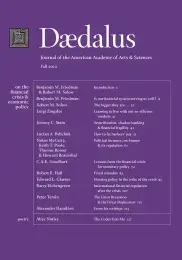Securitization, shadow banking & financial fragility
Many of the most dramatic and memorable moments of the recent financial crisis involved the failures or near-failures of some of the nation’s biggest financial institutions: Bear Stearns, Lehman Brothers, and AIG, to name a few. Much of the subsequent policy response has been shaped by a desire either to avert such failures in the future–for example, by imposing higher capital requirements on systemically important financial firms–or to lessen the adverse consequences of failures if they do occur–for example, by improving the methods available to resolve large institutions in distress.
Yet from the perspective of credit creation and impact on the rest of the economy, one of the most damaging aspects of the crisis was not just the problems of these big firms, but also the collapse of an entire market, namely the market for asset-backed securities (ABS). For example, the market for so-called traditional or consumer ABS–those based on credit-card, auto, and student loans–averaged between $50 and $70 billion of new issuance per quarter in the years leading up to the crisis. (The total issuance for calendar year 2007 was $238 billion.) However, in the last quarter of 2008, following the bankruptcy of Lehman, total issues in this category fell to slightly more than $2 billion. Given that banks were suffering their own problems and were not easily able to step into the breach, the disappearance of this market represented a major contraction in the supply of credit to consumers, and may well have played a central role in the steep drop in aggregate consumption that occurred at this time. The traditional ABS market only began to rebound in mid-2009, with the implementation of the Federal Reserve’s Term Asset-Backed Lending Facility, or TALF, which made tens of billions of dollars of Federal Reserve loans available on attractive terms to investors seeking to buy newly issued consumer ABS.
In what follows, I explore the role that the ABS market plays in the broader process of credit creation, focusing on four sets of issues. First, I describe how the market works: how pools of loans (for example, mortgages or credit-card and auto loans) are packaged and structured into ABS and how investors such as hedge funds, pension funds, and broker-dealer firms finance the acquisition of these ABS. Second, I outline the economic forces that drive securitization; these include both an efficiency-enhancing element of risk-sharing and a less desirable element of banks trying to circumvent regulatory capital requirements. Third, I discuss the factors that appear to have contributed to the market’s fragility during the crisis period. Finally, I suggest some policy reforms that might help mitigate this fragility going forward.
. . .
